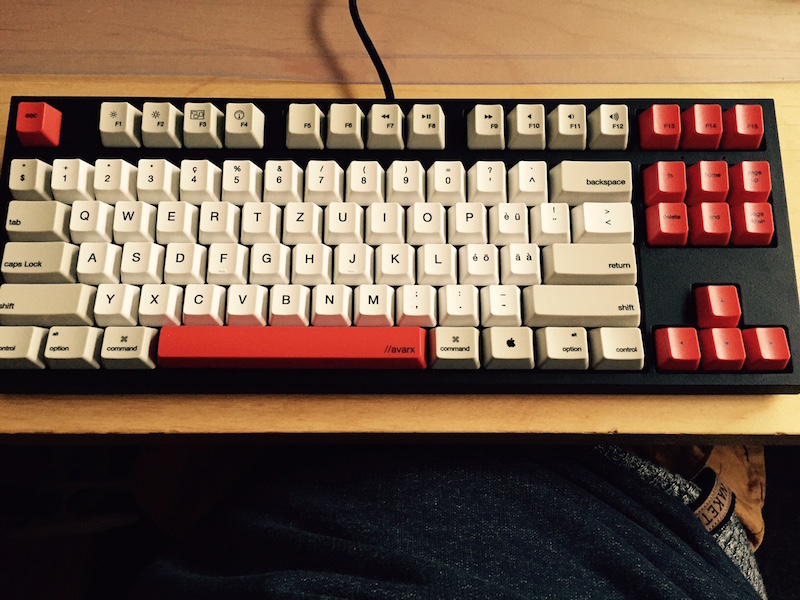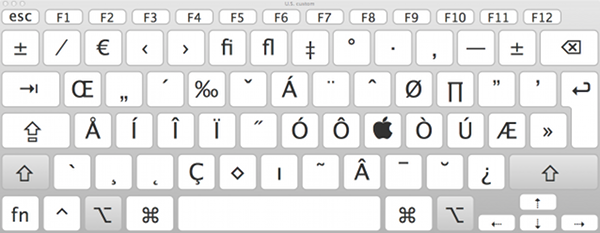Library Keyboard Layouts Mac
Posted : admin On 09.12.2020| Home | Products | Teensy | Blog | Forum |
| You are here:TeensyTeensyduinoUSB Keyboard |
Ukelele is a Unicode Keyboard Layout Editor for the macOS. The macOS supports an XML-based format for keyboard layouts (.keylayout files). However, modifying keyboard layouts—let alone creating entirely new keyboard layouts, such as for a new script—by directly editing the XML text is tedious and error-prone. The layout you are using should be automatically set up when you initially configured your system, but you can always go to the Keyboard system preferences and choose a different layout if you. You can change the keyboard layouts in the menu if you click the keyboard icon next to the battery indication. You can also make a key combination have the layouts switch. Go to System Preferences Keyboard Shortcuts Input Sources and make sure the “Select the previous input source” is selected. Ukelele: Create a Custom Keyboard Layout Ukelele is an application that lets users edit, or create custom keyboard layouts on their Macs. The app has a simple, easy to understand interface. You can create a layout from scratch, by manually filling up the functions performed by various keys on your Mac’s keyboard. MacOS has a system-wide mechanism to let you define or modify the shortcut keys for text editing operations. It lets you create keys to: Insert math symbols, emoji, or any template text. Move cursor by word, page up/down.
How to Unhide the Library Folder the Apple Way You can access the hidden Library folder without using Terminal, which has the side effect of revealing every hidden file on your Mac. This method will only make the Library folder visible, and only for as long as you keep the Finder window for the Library folder open.
|
Your PC orMac will detect a new keyboard. Then your program can send keystrokeswhich your computer will recognize as coming from a standard USB keyboard. There are two ways you can make your Teensy send USB keystrokes. The Easy Way: Keyboard.print()Keyboard.print() works the same way as Serial.print(), except the messageis typed as keystrokes. You can print strings, numbers, single characterswith all the same control as Serial.print().Here is a very simple example, using Keyboard.print(). When this program is run, it will type 'Hello World' and the increasing count.As you can see in this screenshot, the computer sees a USB keyboard and thekeystrokes directly enter the Arduino editor. If delay(5000) had not been used,the result could be very unpleasant. Sometimes 'Hello World 0' may not appear. The PC takes a brief time todetect the presence of a new USB device, but this program begins runningimmediately. If you use Keyboard.print() before the PC finishes the detectionprocess (called 'enumeration' in USB lingo), Keyboard.print() does nothing.A delay() can be added in setup(). Keyboard LayoutsThe Tools > Keyboard Layout menu selects the type of keyboardTeensy will emulate. This setting takes effect when you Upload to Teensy.If you see the wrong characters from Keyboard.print(), Teensy may be emulatinga US keyboard layout, but your computer expects a non-US keyboard, or vise-versa.The layout setting only affects Keyboard.print() and Keyboard.write(). Using PushbuttonsMany projects need to send messages to a computer when pushbuttons are pressed.The Bounce library provides the easiest way to reliably detect pushbuttons changes.This code shows the basic approach. Just update()each object, and then use thefallingEdge() to check if it has changed. For a complete example:File > Examples > Teensy > USB_Keyboard > Buttons. Individual Key Press / ReleaseSometimes you may need precise keyboard control. Many Windows programswill not recognize a CTRL-C character as a copy command unless the CTRL keyis pressed before and remains held down while the C key is pressed. Someprograms require keys to be held for more than the minimum time.'Home' and 'Print Screen' and other special can not be represented in anormal string usable with Keyboard.print().You can use Keyboard.press(key) and Keyboard.release(key) to send individualkey press and release events. The 'key' may be ordinary characters, or specialkey codes. All Keys Codes
TODO: document the 8 media key codes and the special set_media() function. Currently theseonly work on Mac and Linux. Windows does NOT work. A future version will redesignthis feature to hopefully work on Windows too.For now, the only documentation is the example, in File > Examples > Teensy > USB_Keyboard > MediaButtons. The Micro Manager WayThe micro manager way requires more effort but gives you complete control.Normally Keyboard.press(key) and Keyboard.release(key) are sufficient, butthe 'Micro Manager Way' allows you to exactly control the 6 possible key slotsused by the USB communication sent to your PC.Only key codes may be used with the Micro Manager functions. The key codesrepresent the location of a key on the USA English keyboard layout. The keyboardlayout is not used. The media and system keys are not supported. With this way,you are very directly controlling the actual key codes without any extra softwaretranslation! The USB keyboard can have up to 6 normal keys and 4 modifier keys pressed at thesame time. To micro manage the keyboard, you use functions to set which combinationof keys you want pressed (and zero for the ones you want not pressed), and thenuse Keyboard.send_now() to send each combination. You can use delay() or write code to check millis() between calling Keyboard.send_now(),to create the condition of a key held down similarly to a human typing.Auto-repeat is done by the driver on your PC or Mac, so if you have a longdelay between pressing and releasing a normal key, the auto-repeat feature maydeliver many key events to software. When micro managing, you need to send a zerofor each key you've pressed to cause that key to be released (as if a finger werelifting off the key and its spring were returning it to the resting position). Modifier KeysThere are 4 modifier keys: Shift, Alt, Ctrl, and GUI. GUI is either the 'windows key' (PC)or the 'clover key' (Macintosh), usually located to the side of the space bar. These 4keys are special, and can only be used with Keyboard.set_modifier().
If you want no modifier keys pressed, use a zero. To press just one modifier is simple. To press more than one modifier, use the logic OR operator. For example: Normal KeysSix keys are always tranmitted by the USB keyboard. Normally, only the first key isused and the other 5 are zero. However, you can use the 6 keys in any way you like.For example, this code would send keys A, B, C, D, E and F, all pressed at once.To release a key, you must set it to zero. For the above example, all sixwould need to be set back to zero if the next Keyboard.send_now() shouldnot have any of these 6 keys pressed. Keyboard.send_now()After you have set the normal and modifier keys, use Keyboard.send_now()to communicate that combination to the PC or Mac.The keys remain as you set them, so between each call to Keyboard.send_now(),you only need to make the changes you need. For example, this code wouldsend a CTRL-ALT-DELETE sequence. It is important to set normal keys back to zero and send. If you do not, thekey will remain pressed, and the PC or Mac USB driver will begin auto-repeat. If you are familiar with the older PS/2 keyboard 'scan codes', please be awarethat USB keyboard codes work differently (and use different numerical values).The old scan codes sent differentmessages for key down and key up events, where each message represented a singlekey's change. With USB, each message represents the complete state of the keyboard.Up to any 6 keys may be pressed at once, plus any combination of the 8 modifier keys. Bandwidth - Less Than You Might ExpectUSB Keyboard speed is limited to 500 keystrokes per second, and some operatingsystems may limit the speed to only 62.5 keystrokes per second. There is nothingyou can do about these limits. Reading the rest of this section will onlyhelp you understand why they exist.The HID protocol is used by USB keyboards, and HID uses the USB 'interrupt'transfer type, which allocates 1 packet per a configurable number of USBframes. Each USB frame is 1ms, and the Teensyduino USB keyboard coderequests the interval to be every frame. If the operating system honorsthis request, bandwidth is available for 1000 packets per second. Each keystroke requires 2 calls to Keyboard.send_now(), the first to pressthe key and the second to release it. This translates to 500 keystrokes persecond. Of course, you can send 10 different keys in each, but logic insidethe USB device driver will analyze for changes, which imposes a practicallimit, especially when sending to already-written software which expects'normal' typing. Some operating systems might disregard the request and instead schedule 1packet every 8 frames. At 16ms each, only 62.5 keystrokes per second arepossible. Some software, even when running on a multi-gHz, multi-core processor mayperform so much work per keystroke (or be written so infficiently),that sending at such 'fast' speeds could overwhelm the computer. You mightneed to add extra delays. USB keyboard is slow. If you need substantial bandwidth, use USB serial. | ||||||||||||||||||||||||||||||||||||||||||||||||||||||||||||||||||||||||||||||||||||||||||||||||||||||||||||||||||||||||||||||||||||||||||||||||||||||||||||||||||||||||||||||||||||||||||
Released:
Hook and simulate keyboard events on Windows and Linux
Project description
Take full control of your keyboard with this small Python library. Hook global events, register hotkeys, simulate key presses and much more.
Features
- Global event hook on all keyboards (captures keys regardless of focus).
- Listen and send keyboard events.
- Works with Windows and Linux (requires sudo), with experimental OS X support (thanks @glitchassassin!).
- Pure Python, no C modules to be compiled.
- Zero dependencies. Trivial to install and deploy, just copy the files.
- Python 2 and 3.
- Complex hotkey support (e.g.
ctrl+shift+m, ctrl+space) with controllable timeout. - Includes high level API (e.g. record and play, add_abbreviation).
- Maps keys as they actually are in your layout, with full internationalization support (e.g.
Ctrl+ç). - Events automatically captured in separate thread, doesn't block main program.
- Tested and documented.
- Doesn't break accented dead keys (I'm looking at you, pyHook).
- Mouse support available via project mouse (
pip install mouse).
Usage
Install the PyPI package:

or clone the repository (no installation required, source files are sufficient):
or download and extract the zip into your project folder.
Then check the API docs below to see what features are available.
Example
Known limitations:
- Events generated under Windows don't report device id (
event.device None). #21 - Media keys on Linux may appear nameless (scan-code only) or not at all. #20
- Key suppression/blocking only available on Windows. #22
- To avoid depending on X, the Linux parts reads raw device files (
/dev/input/input*)but this requires root. - Other applications, such as some games, may register hooks that swallow allkey events. In this case
keyboardwill be unable to report events. - This program makes no attempt to hide itself, so don't use it for keyloggers or online gaming bots. Be responsible.
Release historyRelease notifications RSS feed
0.13.5
0.13.4
0.13.3
0.13.2
0.13.1
0.13.0
0.11.0
0.10.4 /antares-auto-tune-efx-free-download-crack.html.
0.10.3
0.10.2
0.10.0
0.9.13
0.9.12
0.9.11
0.9.10
0.9.9
0.9.8
0.9.7
0.9.6
0.9.5
Macos Library Keyboard Layouts
0.9.4
0.9.3
0.9.1
0.7.1
0.7.0
0.6.8
0.6.7
0.6.6
0.6.5
0.6.4
0.6.3
0.6.2

0.6.1
0.6.0
Download files
Download the file for your platform. If you're not sure which to choose, learn more about installing packages.
| Filename, size | File type | Python version | Upload date | Hashes |
|---|---|---|---|---|
| Filename, size keyboard-0.13.5-py3-none-any.whl (58.1 kB) | File type Wheel | Python version py3 | Upload date | Hashes |
| Filename, size keyboard-0.13.5.zip (71.8 kB) | File type Source | Python version None | Upload date | Hashes |
Library Keyboard Layouts Mac Os
Hashes for keyboard-0.13.5-py3-none-any.whl
| Algorithm | Hash digest |
|---|---|
| SHA256 | 8e9c2422f1217e0bd84489b9ecd361027cc78415828f4fe4f88dd4acd587947b |
| MD5 | 1668622367c3381c5f12947a4196ac65 |
| BLAKE2-256 | 5588287159903c5b3fc6d47b651c7ab65a54dcf9c9916de546188a7f62870d6d |
Library Keyboard Layouts Machine
Hashes for keyboard-0.13.5.zip
| Algorithm | Hash digest |
|---|---|
| SHA256 | 63ed83305955939ca5c9a73755e5cc43e8242263f5ad5fd3bb7e0b032f3d308b |
| MD5 | d0d1c7a6f34e664f5cedea9a2838da0c |
| BLAKE2-256 | 7975c969f2258e908c39aadfc57d1cb78247dc49e6d36371bb3a48c194640c01 |